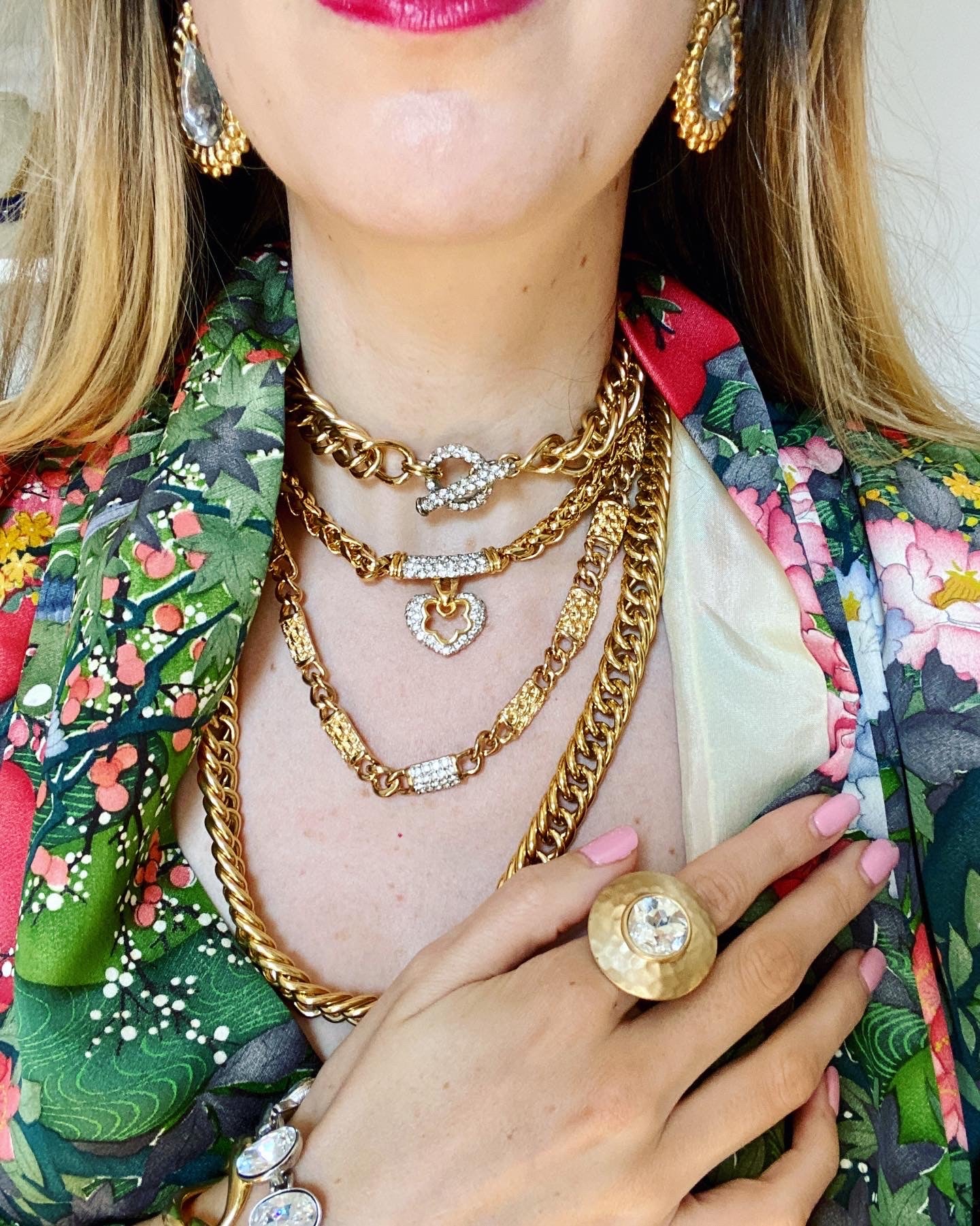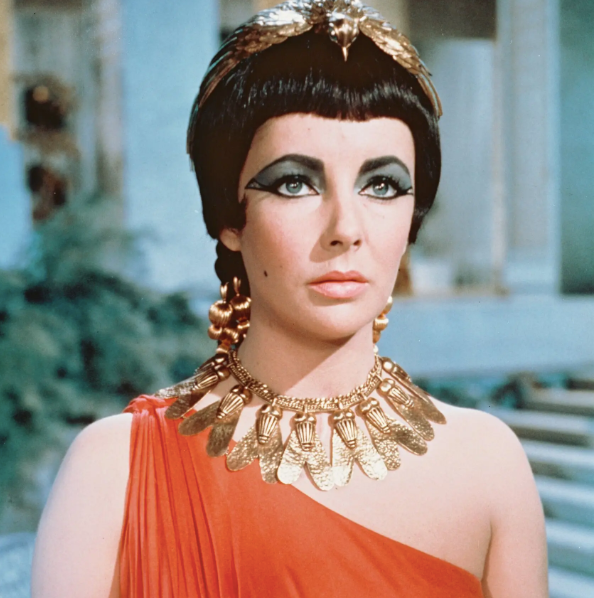
Jewelry 101 with KD: Basic Terminology
Recently I was thinking about all the terms I use on KD and during my trunk shows. There are so many ways to describe jewelry from design motifs to the more technical description of the elements that make up a piece. I decided to put together a mini dictionary of terms that you will encounter while building your collection. This is by no means a complete list, but a great place to start your education.
Types of Gold:

Gold Plated Sterling Silver Tiffany & Co. Bracelet
- Gold Plate: When a piece is gold plated that means that there is a layer of gold over another type of metal. You will usually see this done with silver or copper. It can be done through chemical or electromagnetic processes.

- Vermeil: Is the thickest gold plating you will see in gold plated jewelry. It is gold plating that is at least 2.5 microns thick.
- Gold filled: Is identified by a stamp of “GF” after the karat mark on a piece of jewelry. It Is a layer of gold that has been pressure bonded to a core of another metal. These layers are thicker than plated pieces since they are required to be at least 1/20 or 5% gold by weight. The gold layer must also be at least 10K.
- 10-24K Gold: Solid gold is a very soft metal that can show signs of wear quickly. Gold is alloyed with other metals, such as copper, to make a more durable piece of jewelry. The karat number denotes how much of the whole is made up of gold. 24 karat gold is solid gold, so everything under that is expressed as a fraction. If something is 12 karat, 50% of the alloy would be gold.
Types of Pearls:

Elizabeth Taylor wearing the La peregrina pearl, a baroque pearl with a royal pedigree
- Natural/Baroque: Natural pearls are rarely perfectly round. In the days before cultured pearls, perfectly round pearls could fetch prices higher than diamonds. Most are considered baroque, which means that there could be minor aberrations to the surface up to odd shapes of the pearl.

- Glass: A type of imitation pearl made with a glass bead that is coated with a pearlescent coating. They have a satisfying heft to them since they have a glass core.
- Plastic: An imitation pearl made with a plastic sore that has been smoothed and then coated with a pearlescent coating.

Mikimoto Kōkichi inserting a nucleus into a mollusk
- Cultured: Cultured pearls were developed by Kokichi Mikimoto in 1893. They were accepted as identical to natural pearls. Mollusks are raised and “seeded” with a nucleus made from mother of pearl.
Types of Stones:

A beautiful example of a blue Gripoix poured piece of glass in a vintage necklace
- Gripoix: Is one of the most misidentified elements in costume jewelry in the market today. It is not a mass produced glass stone, it is handmade as it has been since 1868. It is often only found in designer pieces as the process is labor intensive and expensive. True Gripoix is from the atelier, where the glass is melted and poured into molds. They have a better color, shine, and transparency than other glass stones. Gripoix is most famously seen in vintage Chanel jewelry.

- Cabochon: An unfaceted stone that has a rounded, or convex, convex side with a flat reverse. The stones are highly polished. This style of gem preparation dates to before gemstone cutting was developed. You will find cabochons in many of the crown jewels around the world.
- Rhinestones: They are paste stones that are made to look like gems. They are faceted, and are often foiled back to give more luster. They can be made from rock crystal, glass, or polymers.
- Swarovski: Is an Austrian brand of lead crystal. Their pieces are known for having a very uniform structure which gives them extreme clarity. They make stones for jewelry as well as decorative objects for the home.
Types of Clasps:
- Lobster: Lobster clasps are a type of trigger clasp. They are known for being thick and heavy, which enables them to handle more wear and tear. They can come in a variety of sizes and are used on multiple types of jewelry.
- Toggle: A clasp that features a circle with a connecting bar that is inserted to the circle to wear the necklace. The great thing about the toggle style is that it is possible to be used as a focal point for a necklace rather than just a functional closure. This style has been popular through the year, and reminds many of the Return to Tiffany collection popular in the early 2000s.
- Spring Ring: A circular clasp that opens when you push back on a little lever that slides along the ring. Once the clasp is open you will insert the other end of the chain to secure it around your neck or wrist.
- Open Box: Is a clasp that features a wedge-shaped piece that will compress when inserted into the box on the opposite end of the chain. There will be a mechanism that clicks into place that keeps the two ends connected.
Types of Chains:

A gold plated omega collar necklace
- Omega: The omega chain is a necklace that is made of metallic plates that are affixed to a wire or woven mesh. The plates make the chain appear to be links when they are not. The strength of the chain comes from the underlying structure such as the wire. These will be often used with bulkier pendants since the chain is often substantial.
- Rope: The rope chain consists of several small links which pattern the shape of a rope. They can come in different lengths and thicknesses. The texture of the links allows the chain to catch the light, and its range of thicknesses means it can be used by itself or with a multitude of pendant styles. It is a very popular style of necklace for both men and women.
- Wheat: A wheat chain is made up of four strands of twisted oval links. They can appear to look like a rope necklace but upon closer look there will be gaps between the links. The chain is not hollow and is very strong because of this.

- Snake: The snake chain is a style that resembles the body of a snake. It is very flexible and is very fluid in its movement. The chain consists of small rings (or bands) that are tightly joined to create a continuous chain. This style of chain can be more delicate and is often very narrow.
- Herringbone: The herringbone chain can be dated back to Ancient Egypt. This is a flat style of chain that has slanted links that are parallel to each other. These chains can be delicate and most damage comes from people trying to wear pendants on the chain.
- San Marco: The San Marco chain is made up of hollow long and rounded links that are flat on the back and arranged at a diagonal angle next to each other.
- Popcorn: The popcorn chain is tube like in its construction with a beaded structure. The beading gives the chain a puffed appearance that is reminiscent of a strung popcorn. The necklace is very lightweight.

- Curb: The curb Chain is made up of flat, interlocking links. The links are uniform in size and shape. It is a style that has been around for hundreds of years but continues to be in fashion. The shape of the links can range from circles to squares.
- Paper clip: The paperclip chain is made up of thin oval links that look like paper clips. The style can be a standalone chain or can be worn with a pendant. It can be dressed down or up depending on your mood.

- Mesh: The mesh chain is made by weaving together fine wire to create the chain. The movement of the chain is fluid like a piece of fabric.



Leave a comment
This site is protected by hCaptcha and the hCaptcha Privacy Policy and Terms of Service apply.